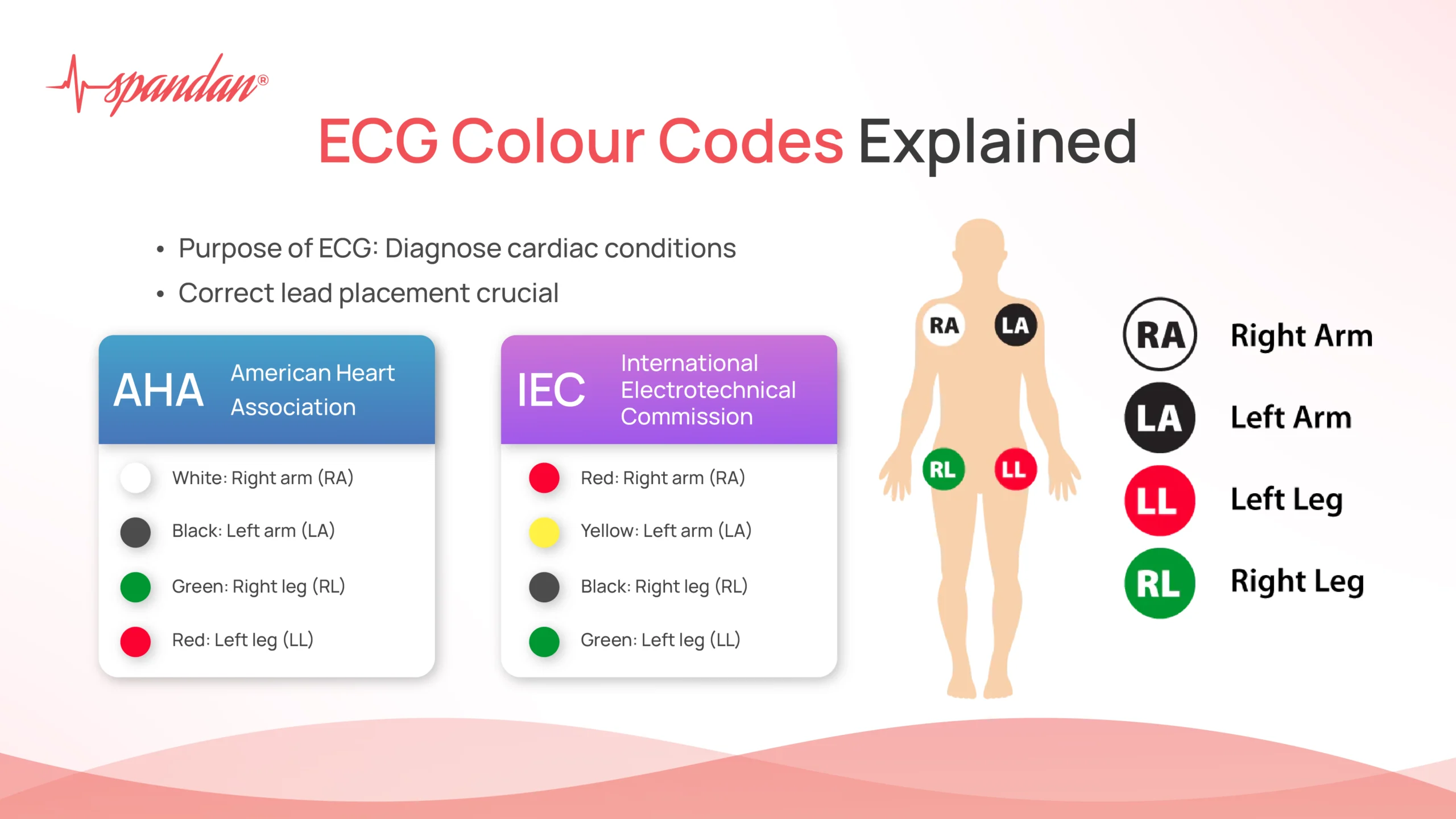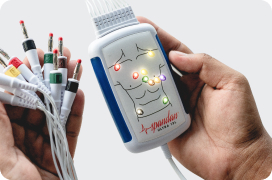
Author:- Mr. Ritesh Sharma
Electrocardiography (ECG or EKG) is a fundamental diagnostic tool in modern medicine, providing crucial information about the electrical activity of the heart. One of the often overlooked, yet essential aspects of ECG usage is the ECG Colous Codes used for the leads. The ECG colous codes ensure correct placement and functionality, contributing significantly to the accuracy of the readings. This blog aims to demystify ECG colour codes, explaining their importance and standard practices across different regions.
What is an ECG?
Before diving into ECG colour codes, it’s essential to understand what an ECG is and its purpose. An ECG records the electrical signals in the heart, producing a waveform that healthcare providers use to diagnose various cardiac conditions such as arrhythmias, myocardial infarctions, and other heart-related issues. The standard 12-lead ECG involves placing electrodes on specific parts of the body to capture comprehensive cardiac activity from multiple angles.
The Importance of Correct Lead Placement
Correct 12 lead ECG placement is crucial for accurate ECG readings. Misplaced leads can result in misinterpretation of the heart’s electrical activity, leading to incorrect diagnoses and treatment plans. The color-coding system is a standardized method to ensure that each electrode is placed correctly and consistently, thus improving the reliability of ECG readings.
The Basics of ECG Colous Codes
Although there are slight variations in color coding systems used around the world, the American Heart Association (AHA) and the International Electrotechnical Commission (IEC) have established widely accepted standards.
American Heart Association (AHA) Color Code
The AHA color code is commonly used in the United States and is recognized for its simplicity and ease of use. Here is a breakdown of the AHA color codes:
- Right Arm (RA): White
- Left Arm (LA): Black
- Right Leg (RL): Green (often referred to as the ground or neutral electrode)
- Left Leg (LL): Red
- Chest (Precordial) Leads:
- V1: Red
- V2: Yellow
- V3: Green
- V4: Blue
- V5: Orange
- V6: Purple
International Electrotechnical Commission (IEC) Color Code
The IEC color code is more commonly used in Europe and other parts of the world. It includes the following:
- Right Arm (RA): Red
- Left Arm (LA): Yellow
- Right Leg (RL): Black
- Left Leg (LL): Green
- Chest (Precordial) Leads:
- V1: Red
- V2: Yellow
- V3: Green
- V4: Brown
- V5: Black
- V6: Purple
The Importance of ECG Colour Codes
The correct interpretation of an ECG is highly dependent on the accurate placement of electrodes on the patient’s body. Electrodes pick up electrical impulses from the heart and transmit them to the ECG machine, which then produces a visual representation of the heart’s electrical activity. Each electrode placement corresponds to specific leads on the ECG, and any misplacement can lead to incorrect diagnosis.
Color coding of ECG electrodes simplifies the process of placement, reducing the risk of errors. This is particularly important in emergency situations where time is of the essence. Additionally, standardized color codes ensure consistency across different healthcare settings, making it easier for medical professionals to work in various environments without confusion.
Electrode Placement and Its Clinical Relevance
Proper placement of ECG electrodes is critical for obtaining an accurate reading. Here’s a step-by-step guide for placing the electrodes according to the AHA color code:
Limb Leads
- Right Arm (RA): Place the white electrode just above the right wrist.
- Left Arm (LA): Place the black electrode just above the left wrist.
- Right Leg (RL): Place the green electrode on the right ankle.
- Left Leg (LL): Place the red electrode on the left ankle.
Precordial (Chest) Leads
- V1 (Red): Place in the fourth intercostal space at the right sternal border.
- V2 (Yellow): Place in the fourth intercostal space at the left sternal border.
- V3 (Green): Place halfway between V2 and V4.
- V4 (Blue): Place in the fifth intercostal space at the midclavicular line.
- V5 (Orange): Place horizontally with V4 at the anterior axillary line.
- V6 (Purple): Place horizontally with V4 at the midaxillary line.
Tips for Accurate Electrode Placement
- Prepare the Skin: Clean the skin with alcohol wipes to remove any oils and dirt. Shave excessive chest hair if necessary to ensure good electrode contact.
- Correct Positioning: Make sure the patient is lying down comfortably. For limb leads, ensure the arms and legs are relaxed to avoid muscle interference.
- Check Connections: Ensure all electrodes are securely attached and the connections to the ECG machine are firm.
- Monitor Lead Placement: Be mindful of the exact anatomical landmarks for placing precordial leads to avoid misplacement.
- Recheck During Recording: Occasionally check the electrodes during the ECG recording to ensure they remain in place, especially if the patient moves.
Common Issues and Troubleshooting
Despite best efforts, issues with ECG readings can still arise. Here are some common problems and their solutions:
- Artifact: Electrical interference or patient movement can cause artifacts. Ensure the patient is still and the environment is free from electrical devices that might interfere.
- Poor Contact: Dry or hairy skin can lead to poor electrode contact. Reclean the skin, use conductive gel, or replace the electrodes if necessary.
- Incorrect Lead Placement: Misplacement of leads can significantly alter the ECG reading. Double-check the placement according to the color codes and anatomical landmarks.
- Loose Connections: Ensure that all connections between the electrodes and the ECG machine are secure and not loose.
In conclusion, understanding ECG color codes and the correct placement of electrodes is fundamental for healthcare professionals. It ensures accurate ECG recordings, which are vital for diagnosing and monitoring cardiac conditions. The standardized color codes by the AHA and IEC provide a reliable system to minimize errors and improve the consistency of ECG recordings across different settings. By following the proper placement guidelines and troubleshooting common issues, medical practitioners can enhance the quality of ECG readings, ultimately leading to better patient outcomes.




